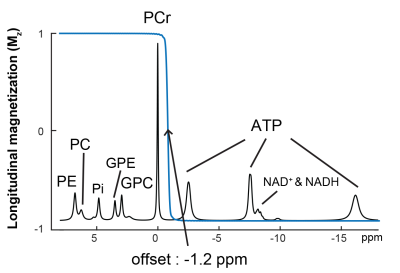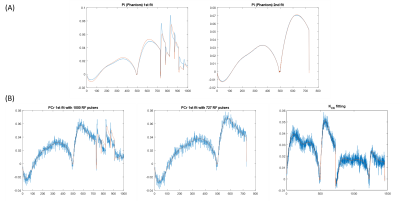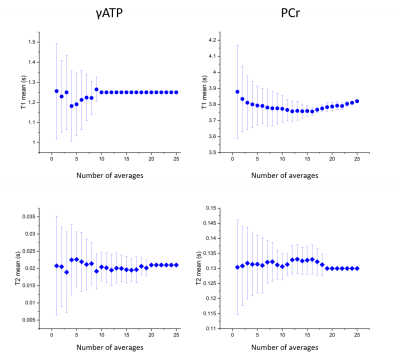0174
Fast acquisition of 31-P creatin kinease chemical exchange rate and relaxation rates of γ-ATP and PCr in vivo human brain at 7T using MRS-FP1Laboratory for Functional and Metabolic Imaging, CIBM, EPFL, Lausanne, Switzerland, 2Animal Imaging and Technology, CIBM, EPFL, Lausanne, Switzerland
Synopsis
This study shows preliminary results of the feasibility using MRS-FP to measure the relaxation parameters of γ-ATP and PCr as well as the chemical exchange rate kCK. All results were in good agreement with literature values enabling a fast and robust 31 P multi parameter estimation in vivo human brain at 7T .
Introduction
ATP is known to be fundamental for supporting various cellular activities in human brain. A stable ATP concentration is maintained by PCr acting as an reservoir and carrier in the creatine kinase cycle. This transfer rate kCK is usually studied by in vivo 31P MRS combined with magnetization transfer(MT) [4-7]. However these methods are time consuming, due to the long relaxation time of PCr and the low signal strength in 31-P MRS. In this abstract a 31-P MRS-FP method is introduced based on MR-fingerprinting [1]. MR-fingerprinting is a recently introduced measurements framework for MRI multi parametric mapping in human brain. Using a fast steady state free precision type sequence it is able to give time efficient and robust results even for low signals. In a preclinical study [2] and for single voxel proton MRS [3], it was already proven to be promising to measure multi-parameters in a short period of time. in the preclinical study it was even shown that with a two pool model the kCK can be measured. This study shows preliminary results of the feasibility using MRS-FP to measure the relaxation parameters of γ-ATP and PCr as well as the chemical exchange rate kCK in vivo human brain.Methods
The MRS-FP approach is a b-SSFP like scheme with fast repeating slice selective 2 ms sinc pulses (Figure 1). The TR is set constant (16 ms) with a sampling rate of 512 points per 10 ms acquisition time. The scheme consists out of 2 parts. Part one starts with a global inversion pulse followed with 20 ms delay by 1000 RF excitations. The sinusoidal shapes in the first half showed to be sensitive for T1 and T2 changes (relaxation part), where as the second fast changing half helps to separate B1+ inhomogeneities and line width effects from T2 changes in the pattern (inhomogeneity part) [8]. After 5 sec relaxation time the second part inverts asymmetrically (Figure 2) only α, β and γ-ATP. After 20 ms delay 730 FAs in the same sinusoidal pattern as in part one are used (kCK part). Only inverting the ATPs will introduce a chemical exchange in between γ-ATP and PCr, giving rise to changes in the Pattern. 25 averages with two dummy scans were acquired, resulting in a total scan time of 16 min.The dictionary was created using the Bloch-McConnel equations using a two-pool model similar to [2]. Slice profile correction [9] and B0 inhomogeneity were incorporated in the simulation resulting in 8 parameters to fit. To solve this highly non convex problem an iterative approach was used. First the inhomogeneities were determined by fitting separately the relaxation part plus the inhomogeneity part using literature values for the relaxation times of γ-ATP and PCr. With the fitted B0, B1+ values a second dictionary was created to fit the relaxation parameters separately from each other with the relaxation part. Last a combined fingerprint of γ-ATP and PCr of the kCK part was used to determine the ratio and kCK.MR experiments was performed on a 7T/68cm MR scanner (Siemens Medical Solutions, Erlangen, Germany) with a 1H quadrature surface coil (10cm-diameter) and a single-loop 31P coil (7cm-diameter) for the occipital lobe.A phantom with 100 mM Pi and 0.016 mM Gadovist was used to test the feasibility of the MRS-FP sequence. T1 value was acquired using inversion recovery and T2 value using a multi-TE approach in sSPECIAL sequence. One healthy individual(40 years) provided written informed consent was scanned with the MRSFP approach and values were compared with literature.
Results
Figure 3 a) shows the fitted curves for the data acquired in the phantom. and the two step procedure to get the relaxation parameters. The estimated T1 and T2 values were in agreement with the values measured with the gold standard methods. Figure 3 b) shows the 3 step in vivo procedure to estimate kCK. The fitted relaxation values were in agreement with literature values (Figure 4). The chemical exchange rate was found by dividing through the fitted concentration rate of Mγ-ATP=0.6 MPCr. Figure 5 shows mean and standard deviation by applying different sizes of sliding averages on the data to examine the effect of averaging acquisitions and reliability of the estimates for lower SNR. Even with a lower number of averages a reliable estimation is possible.Discussion and conclusion
As a proof of concept, a noise robust acquisition of multiple parameters was shown that MRS-FP promises a fast measurement of the chemical exchange rate kCK in vivo human brain. Since the kCK estimation manly relies on the accurate estimation of T1 and T2 of PCr and γ-ATP even less number of averages as in this study could be used reducing the scan time by a factor of 4-8. Further studies with more volunteers need to be done to prove the reliability of these method.Acknowledgements
This work was supported by the Swiss National Science Foundation (grants n° 320030_189064). We acknowledge access to the facilities and expertise of the CIBM Center for Biomedical Imaging, a Swiss research center of excellence founded and supported by Lausanne University Hospital (CHUV), University of Lausanne (UNIL), Ecole polytechnique fédérale de Lausanne (EPFL), University of Geneva (UNIGE) and Geneva University Hospitals (HUG).References
[1] Ma D, Gulani V, Seiberlich N, et al. Magnetic resonance fingerprinting. Nature 2013;495:187–192 doi: 10.1038/nature11971.
[2] Wang CY, Liu Y, Huang S, Griswold MA, Seiberlich N, Yu X. 31 P magnetic resonance fingerprinting for rapid quantification of creatine kinase reaction rate in vivo. NMR Biomed. 2017;30:1–14 doi: 10.1002/nbm.3786.
[3] Kulpanovich A, Tal A. The application of magnetic resonance fingerprinting to single voxel proton spectroscopy. NMR Biomed. 2018;31:1–14 doi: 10.1002/nbm.4001.
[4] Lei H, Zhu XH, Zhang XL, Ugurbil K, Chen W. In vivo 31P magnetic resonance spectroscopy of human brain at 7 T: An initial experience. Magn. Reson. Med. 2003;49:199–205 doi: 10.1002/mrm.10379.
[5] Du F, Zhu XH, Qiao H, Zhang X, Chen W. Efficient in vivo 31P magnetization transfer approach for noninvasively determining multiple kinetic parameters and metabolic fluxes of ATP metabolism in the human brain. Magn. Reson. Med. 2007;57:103–114 doi: 10.1002/mrm.21107.
[6] Du F, Cooper AJ, Thida T, Sehovic S, Lukas SE, Cohen BM, Zhang X, Ongür D. In vivo evidence for cerebral bioenergetic abnormalities in schizophrenia measured using 31P magnetization transfer spectroscopy. JAMA Psychiatry. 2014 Jan;71(1):19-27. doi: 10.1001/jamapsychiatry.2013.2287.
[7] Lei H, Ugurbil K, Chen W. Measurement of unidirectional Pi to ATP flux in human visual cortex at 7 T by using in vivo 31P magnetic resonance spectroscopy. Proc. Natl. Acad. Sci. U. S. A. 2003;100:14409–14414 doi: 10.1073/pnas.2332656100.
[8] Buonincontri, Guido, et al. "Spiral MR fingerprinting at 7 T with simultaneous B1 estimation." Magnetic resonance imaging 41 (2017): 1-6.[9] Ma, Dan, et al. "Slice profile and B1 corrections in 2D magnetic resonance fingerprinting." Magnetic resonance in medicine 78.5 (2017): 1781-1789.
Figures




